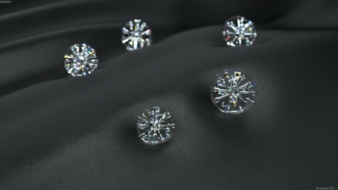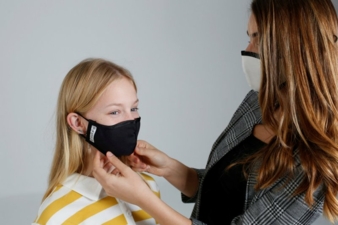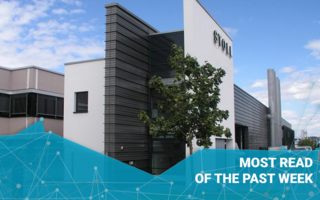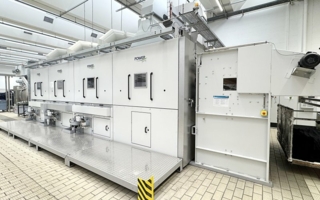26/03/2021 – Antimicrobial textiles — auf Deutsch lesen
Sonovia: Protection against infections
Innovative ultrasonic technology for chemical-mechanical textile finishing protects against infections and reduces environmental impact.
In light of the coronavirus pandemic and the increasing number of hospital infections around the world involving multidrug-resistant pathogens, antimicrobial textiles are coming back into focus.
An innovative, ultrasound-based finishing technology developed by Sonovia, Brückner Textile Technologies, and Weber Ultrasonics now offers some crucial advantages: because the impregnation meets industrial requirements for wash resistance, it remains effective for a long period of time – even against coronaviruses. Furthermore, the new “sono-finishing” process minimizes the environmental impact associated with conventional textile finishing.
Antimicrobial textiles are nothing new?
But because the majority of impregnations that protect against bacteria, viruses, and fungi use chemical binding agents that only deliver limited wash resistance, the protective effect only lasts a certain amount of time. Additionally, the chemicals and substances used can be harmful to the environment. This may not only impact the environment; it can also result in pollutant residues on finished products.
Liat Goldhammer, chief technical officer at Sonovia Ltd.:
“To ensure antimicrobial textiles like those used in clothing for medical workers, hospital linen/laundry, and oronasal masks significantly reduce the risk of infection, the impregnation must be able to withstand frequent laundering at the high temperatures required in the medical sector. They cannot lose efficacy over the course of their normal useful life.”
Sonochemical process offers solution for all types of textiles
In 2017, the Israeli startup began industrializing a patented sono-finishing process developed at Bar-Ilan University in Israel. The one-step, sonochemical finishing process is suitable for all types of textiles – whether they’re made from natural fibers like cotton, linen, and silk, synthetic materials, or a blend of both. The procedure uses zinc-oxide nanoparticles as an active medium and is based on the physical phenomenon of acoustic cavitation: when exposed to ultrasound, small bubbles continuously form in the solution mixed with the nanoparticles, which then expand and collapse within split seconds. This creates high-energy microstreaming patterns, which move at around 500 meters per second. These carry the particles with them and embed them firmly in the textiles.
Liat Goldhammer:
“This is a distinctive feature of our technology versus conventional textile finishing processes that use chemical binding agents. With sono-finishing technology, the particles are mechanically embedded, so the antimicrobial properties remain in place for a long time.”
What’s more, no polluting binding agents are required in the process, and the use of chemicals can be reduced by up to 50 percent. The formation of cavitation bubbles via ultrasound is crucial to ensure the reliable application of the antimicrobial zinc-oxide particles. Standard ultrasonic systems cannot be used for this.
Strong partners for industrialization
To transfer the technology from the university laboratory to large-scale industrial production, Sonovia partnered with Brückner Textile Technologies, a manufacturer of textile finishing systems and process technology developer, as well as Weber Ultrasonics, an international manufacturer of ultrasound technology components – both world leaders in their respective industries. “Both companies were impressed by the technology’s potential and entered into partnerships with us. This cannot be taken for granted with such established firms – after all, collaboration with a startup always comes with certain risks,” comments Liat Goldhammer.
While the R&D department at Weber Ultrasonics came up with a made-to-measure ultrasonic concept, Brückner developed and built a corresponding application unit that can also be integrated into a wider, continuous finishing process. The first system prototype for the sonochemical process has been in use at Brückner’s technology center since early 2019.
Technological, environmental, and cost advantages
In addition to ensuring maximum process reliability, key aspects included meeting the modern textile industry's high standards in terms of productivity, reliability, sustainability, ease of maintenance, and cost effectiveness. Compared to conventional textile equipment, the new procedure not only offers the benefits of more long-lasting antimicrobial properties and being more environmentally friendly; it also allows for cost savings.
Liat Goldhammer:
“Although development is not yet complete, initial, conservative calculations suggest potential savings of around 10 percent from the reduction of chemicals used.”
The new application unit, which is similar to a padding mangle, can easily be integrated into existing plants and lines. It can be used for finishing both woven and knitted fabrics, as well as nonwovens and carpeting.
To prove the lasting and reliable antimicrobial efficacy of sonochemical textile finishing, Sonovia conducted testing together with renowned international textile research and certification institutes. The tests confirmed that the finished fabrics still retained their full antimicrobial properties after multiple wash cycles at high temperatures.
Sonovia now manufactures and sells antimicrobial oronasal masks made out of textiles that use this technology. Tests carried out in summer 2020 revealed more than 99 percent efficacy against SARS-CoV-2. Additionally, the mask filters 95 percent of 3 microns particles, the particle size which has been identified by the WHO as relevant to the spread of Covid-19.
The new technology’s proven, lasting protective effects, in addition to the user-friendly and sustainable process, make it an optimal solution for finishing clothing for medical and care workers and laundry/linen in hospitals, senior homes, and hotels, as well as many other areas where hygiene and infection control are critical.
The fashion and sportswear industries, as well as the automotive sector and railroad car fitters are also interested in sonochemically finished textiles. Relevant tests are set to be carried out at Brückner Textile Technologies’ technology center starting in the second quarter of 2021.




